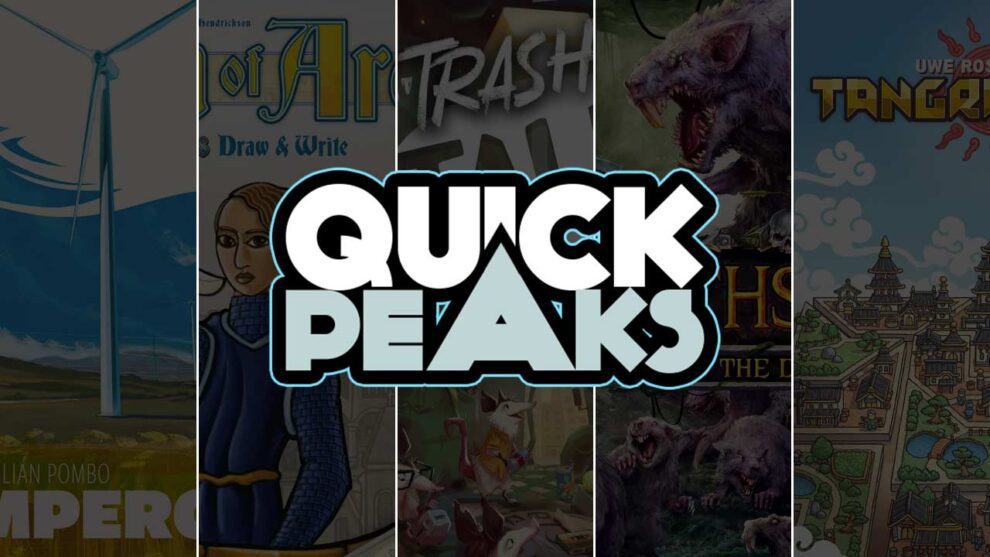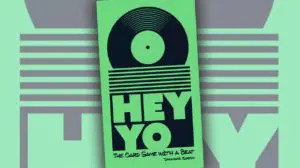Pampero – Justin Bell
Pampero is the new heavy Euro designed by Julián Pombo, who served as the co-designer of Mercado de Lisboa along with Vital Lacerda (Kanban EV, Inventions: Evolution of Ideas, Vinhos: Deluxe Edition). While Pampero is interesting, it plays like a game just shy of something that would hit my table repeatedly.
Players are investors working to build out the energy network of Uruguay by building wind farms and electrical towers across a massive, beautiful playspace graphically designed by Ian O’Toole. Across a short series of turns (18, give or take), players manage a hand of cards to take actions while doing a bunch of Eurogame-y things like boost income tracks, fulfill public contracts, and race other players to have the most of certain icons before each of the game’s three scoring rounds. Pampero looks great, has a ridiculous number of high-end components, provides a fantastic player aid that answered all of my in-game questions, and plays much faster than I would have guessed (an hour and 45 minutes with four players).
But some of the upgraded action cards are strictly better than other cards in the same market, and some of the basic action cards were not used at all during my game, including a loan card and a move bulldozer action. In a game that seems to be about wind farms, the game’s electrical towers carry significantly more weight in terms of bonuses, gated abilities (certain contracts can’t be claimed unless certain electrical towers have been built) and income restrictions. None of us believed that Pampero could be won using a “wind farm strategy”, and the player that focused on building wind farms scored more than a hundred dollars less than the winner. That narrows the focus on viable winning strategies for future plays, and a couple mechanics (bulldozers, turn order, and a portion of the massive generator board) were completely ignored at almost no ill effect to our scores. For a game that already struggles to surmount the interaction and interesting decisions in other heavy Euros—like almost anything done by Lacerda himself—it’s hard to imagine getting Pampero back to the table.
Ease of entry?:
★★★★☆ – The odd bump or two
Would I play it again?:
★★★☆☆ – Wouldn’t suggest it, but would happily play it
Read more articles from Justin Bell.
Joan of Arc: Orléans Draw & Write – Bob Pazehoski, Jr.
I like the _____ & write genre more with each new title. What sets Joan of Arc: Orléans Draw & Write apart from the standard fare is the attempted reduction of an honest to goodness hobby game, Orléans. In other words, this is not a roll & write, nor is it a flip & write. Players draw tokens from a bag to determine the available actions, one of which is selecting an ability card from a grid of 20. I love the incorporation of more robust mechanisms on the way to the inevitable combo-licious outpouring of stuff—goods, coins, books, exploration, etc—endemic to the genre. Joan of Arc has a wonderful and gratifying decision space as a result.
Where Joan of Arc hurts me—and I mean physically hurts me—is in the microscopic print. I can appreciate the desire to simplify the game for newcomers and to make long-distance play a possibility, but the attempt to cram the info from the cards onto the player sheet to make it “easy” is nothing short of a catastrophic fail in the physical product. The cards are larger, easier to read, more aesthetically interesting, and more physically satisfying in their acquisition. The small print induces far more confusion than it relieves, and it forces everything to be the sort of small that accelerates my need for bifocals. Why, Capstone…why?! Either keep the cards and drop the micro-print, or redirect the production cost of cards to make this a two-sheet endeavor.
Thankfully, the game is delightfully engaging and quite fun, especially if you don’t have the game’s older sibling. But if anything will make me go out and buy Orleans, it’s the fine print.
Ease of entry?:
★★★★★ – No sweat (apart from eye strain)
Would I play it again?:
★★★★★ – Will definitely play it again
Read more articles from Bob Pazehoski, Jr.
Trash Talk – Will Hare
My play groups vary wildly from hardcore strategy gamers to people who just want to laugh, drink, and jam 20 games of Cockroach Poker in a row. It’s hard to find a game that can appeal broadly to all groups, though I’m pleased to report that thus far, Trash Talk has landed as a light filler party game that everyone can enjoy.
The premise is simple: one person (the “raccoon”) takes three trash objects from the box and puts them behind their privacy screen. The game comes with an assortment of paired “trash” objects. These range from plastic Slinkys to tiny umbrellas to toy cars. The rest of the group (the “possums”) take the matching objects for themselves. Then, the raccoon flips three word cards. These single word cards are usually nouns, and it’s up to the raccoon to pick which trash object best matches each noun. Once they’re done, the group tries to line up their trash to match the raccoon’s trash. If both sets of objects match, congrats! Add another object and card, then repeat it. Make it all the way to ten to win.
If you fail, you get one chance at redemption with the same objects but new cards. It’s all very silly but the use of physical props in the box really makes the game sing in a fun way. Not to mention, the game encourages you to add your own “trash” to the box to increase the number of items. I’ve had people tossing stuff from their pockets onto the table just to add even more wackiness to an already fun, family-friendly party game.
Ease of entry?:
★★★★★ – No sweat
Would I play it again?:
★★★☆☆ – Wouldn’t suggest it, but would happily play it
Read more articles from Will Hare.
Oathsworn: Into the Deepwood – Jesse Fletcher
Publisher Shadowborne Games bursts onto the board game scene with their debut Oathsworn: Into the Deepwood, a massive 21-scenario campaign game with minis, cardboard, and content galore. Each scenario is split into an adventure/story section, complete with expertly narrated audio via an optional companion app, followed by a boss battler style combat. Every enemy is sealed away into a mystery box with the deluxe mini-laden version, or sealed envelope in the basic standee version. While on first glance it looks like a typical dice-chucking, “beer and pretzel,” beat-em-up hullabaloo, digging deeper reveals a surprising mix of long-term strategy and turn-to-turn tactics. The battle flow system forces the players to plan ahead, as the stronger player cards can take longer to get back into their hand. Player and enemy attacks can be resolved by either dice or cards, depending on how predictable you would like resolution to be. Like Gloomhaven, all the characters have unique player decks that must be selected in advance before entering combat. Oathsworn definitely has a lot going on, but decidedly a lot to love. While the initial learning curve is pretty high, the payoff is as rewarding as it is compelling. I’m looking forward to diving into this one, despite the commitment and complexity it requires.
Ease of entry?:
★★☆☆☆ – Not an easy onboard
Would I play it again?:
★★★★★ – Will definitely play it again
Read more articles from Jesse Fletcher
Tangram City – David McMillan
What do you get if you mix Patchwork Doodle with My City? Chances are, you’d wind up with a game like Tangram City.
Tangram City resembles My City in the way that a card featuring a shape is flipped up each turn to dictate which shape the players will have to work with. Four of these will be flipped up per round. One of these will be in your hand, so you’ll always have knowledge of a puzzle piece that nobody else does.
When a card is flipped up, every player will have the option to place the piece featured on the card into their tableau. In this way, it resembles Patchwork Doodle. It also resembles Patchwork Doodle in the way that scoring is handled at the end of each round. Once the players have handled all four cards for the round, the round ends and players score points for each square in their largest completed rectangle.
But it doesn’t end there. There are also bonus points available based on how well you were able to maintain the balance between green and brown squares in your tableau (each piece has a green side and a brown side), as well as bonus points if you were able to cover every square on your player board.
My first game immediately turned into a second and third game. I’ve been enjoying my time with the game so much so, in fact, that it has become a lunchtime staple. In fact, it’s in my backpack several feet away from me even as I type this.
Keep an eye peeled for my upcoming review.
Ease of entry?:
★★★★★ – No sweat
Would I play it again?:
★★★★★ – Will definitely play it again















Add Comment